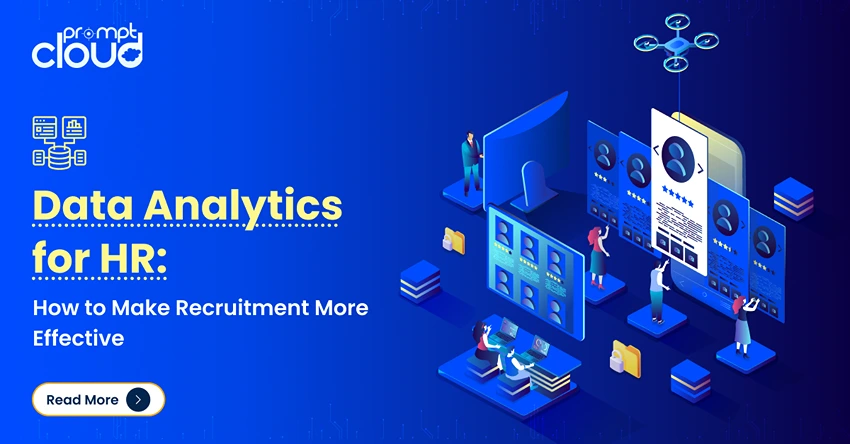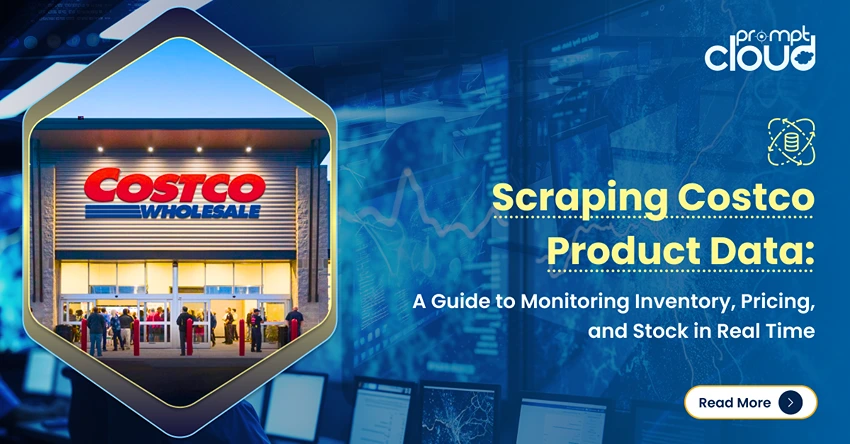
Costco isn’t just a warehouse full of bulk toilet paper and rotisserie chickens—it’s one of the most important retail signals on the internet. What’s in stock, what’s flying off the shelves, how prices are shifting—there’s a goldmine of insight buried in that site. You just have to know how to pull it out.
And let’s be real—Costco doesn’t make it easy. There’s no public API. No fancy dashboards. If you want to know what’s happening with Costco products, you either scroll through pages manually (good luck doing that at scale) or you use something smarter: web scraping.
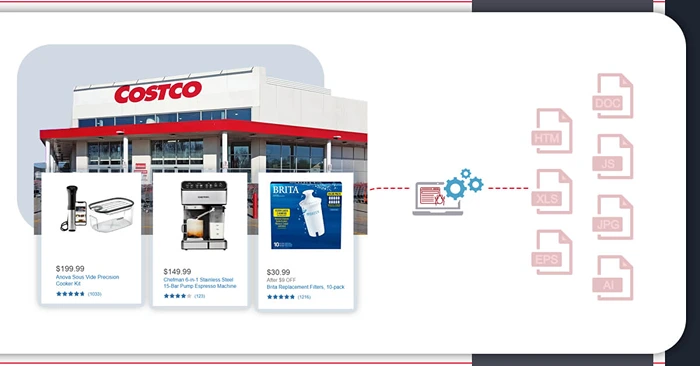
Image Source: iwebscraping
For retail analysts, ecomm teams, CPG brands—anyone trying to make sense of the market—scraping Costco product data can help you monitor stock changes in real time, keep tabs on pricing shifts, and react faster than your competitors. This isn’t just about pulling numbers. It’s about seeing demand patterns, spotting pricing pressure, and making better decisions with better data.
In this guide, I’ll walk you through exactly how web scraping works when it comes to Costco—what you can track, what to watch out for, and how services like PromptCloud take the mess out of the process.
Why Scrape Costco Product Data in the First Place?
Let’s cut to it: Costco moves the needle. When they adjust prices, pull a product off the shelves, or suddenly run out of stock, it’s rarely random. It usually means something bigger is happening behind the scenes. And if you’re in retail, pricing, or supply chain, you want to see that wave before it hits you.
Scraping Costco product data lets you do exactly that. You’re not just pulling numbers for the sake of it. You’re building visibility into how one of the most aggressive, efficiency-obsessed retailers operates in real time.
Here’s what that gives you:
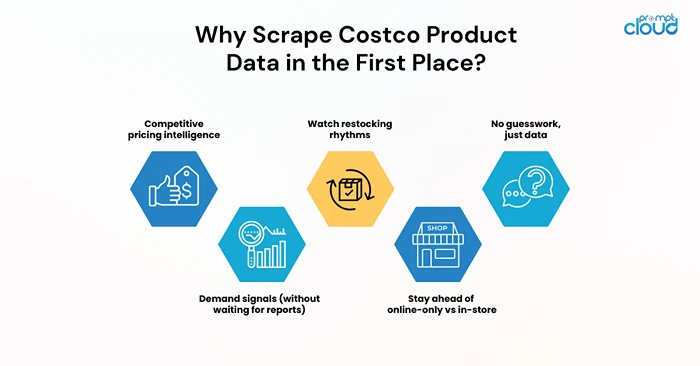
1. Competitive pricing intelligence
Costco is known for keeping prices low. If they cut the price on a product that you or your competitors also sell, it’s probably not a coincidence. Being able to track that—daily, hourly if needed—lets you react faster. You can adjust your own prices, fine-tune your promotions, or push alternate SKUs.
2. Demand signals (without waiting for reports)
When a product disappears from Costco inventory, or it shows as “Out of Stock” in multiple locations, that tells you something. Either it’s selling fast, supply is constrained, or both. These patterns help you spot rising demand way before your standard BI tools pick it up.
3. Watch restocking rhythms
Costco doesn’t restock everything on a fixed schedule. Some products come back in a few days, others take weeks, or never return. By scraping inventory and stock data consistently, you start to see the pattern. That’s pure gold if you’re in logistics or demand forecasting.
4. Stay ahead of online-only vs in-store
Some Costco products are web-only, while others vanish from the site but are still sitting on store shelves. Scraping gives you a clear view into what’s happening online, which often shifts faster than in-store. For DTC brands and resellers, this data is a cheat code.
5. No guesswork, just hard data
Instead of waiting for quarterly earnings or analyst notes, you’ve got your own pipeline. You know what’s out of stock, what’s rising in price, and how often products rotate. And that means less reacting, more predicting.
The point is: if you’re not tracking Costco stock and pricing, you’re flying blind on one of the biggest retail signals out there. And if you think manually checking the site is enough, you’re already behind.
How Web Scraping Works for Costco Products
Scraping Costco’s website isn’t rocket science, but it’s not copy-paste easy either. You’re dealing with a dynamic site, login walls in some cases, location-based availability, and anti-bot tech that’s designed to keep things locked down. If you don’t know what you’re doing, you’ll either get blocked, get bad data, or worse—scrape things that don’t reflect what customers are seeing.
But done right? You can track thousands of Costco products, prices, stock availability, and changes across multiple pages in near real time. Here’s how that process usually works:
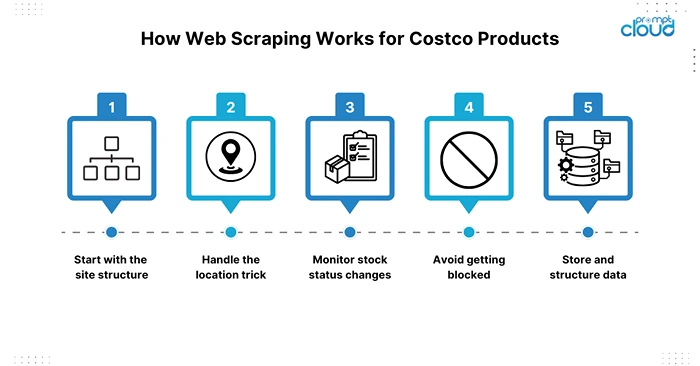
1. Start with the structure
Every page on Costco.com, whether it’s a product, a category, or a search result, has an underlying HTML structure. That’s what scraping tools read. The key is identifying the right tags (like price, stock status, product title, SKU, location availability) and extracting just those without pulling junk data.
This is where a lot of DIY scripts fail. If Costco changes the layout (and they do), your scrapers break. Which is why most serious teams use robust, auto-adaptive scraping setups—or just outsource the whole thing.
2. Handle the location trick
One of the sneakiest parts of scraping Costco inventory is that product availability depends on your ZIP code. What’s in stock in LA might not even show up in NYC. So if you’re tracking inventory across regions, your scrapers need to simulate those locations.
That means setting up proxies, rotating IPs from different geos, or spoofing headers. Not exactly plug-and-play stuff. But if you care about accuracy (and you should), this step is non-negotiable.
3. Monitor stock status changes, not just price
People think web scraping is all about prices, but availability is just as important. Knowing when something flips from “In Stock” to “Out of Stock” tells you exactly when supply drops or demand spikes. Even better? Tracking how long it stays out of stock. That’s how you build your own restock timelines.
4. Avoid getting blocked
Scraping Costco aggressively with no filters will get you IP-banned in no time. They’ve got decent bot detection, especially for repetitive behavior. So, use delay timers, rotate your headers and IPs, and mimic human behavior. Or better yet, work with a provider that already handles this at scale, like PromptCloud. You get the data, they deal with the headaches.
5. Store and structure your scraped data right
Pulling data is one thing. Making it usable is another. You’ll want your output in a clean, structured format—CSV, JSON, whatever fits your pipeline. Organize by SKU, category, timestamp, and region. That’s what makes the scraped data useful for dashboards, pricing engines, or trend analysis.
Bottom line: scraping Costco product data isn’t hard, but doing it well takes some thought. And if you want it done at scale, cleanly, and without babysitting broken scripts every week, you’re better off plugging into a managed web scraping solution.
Real-World Use Cases: How Brands Use Costco Product Data to Compete Smarter
Let’s talk about how teams are using this data, because web scraping isn’t just a cool trick. It’s a real edge in a business where margins are thin and timing is everything.
Here’s what scraping Costco product data looks like in the wild:
1. A CPG brand tracking pricing across retailers
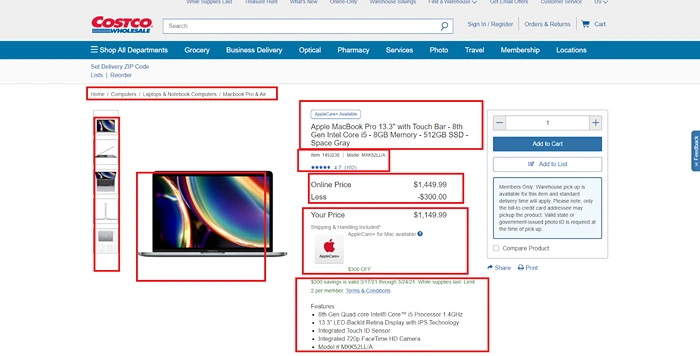
Image Source: webautomation
Let’s say you’re managing pricing at a mid-size CPG brand. You’re sold in Walmart, Target, Amazon, and now Costco is pushing your product hard. But you have no idea how they’re pricing it week to week. And your retail partners sure aren’t telling you.
By scraping Costco prices daily, you can see if they’re undercutting other channels (or blowing up your MAP agreement). If they drop the price, you can predict when your other retail partners will follow. It’s not about watching—it’s about staying ahead.
2. An e-commerce player using Costco inventory to predict demand
You’re running a DTC site that sells electronics. One of your SKUs overlaps with a hot-selling Costco product. You track their inventory daily and notice something interesting: stock’s been out for 4 days in a row, and the price hasn’t changed.
That tells you two things. One: demand’s probably spiking. Two: they’re not discounting to clear. That’s your moment to push paid ads or bump your product into a featured section. Because people looking for that product are now looking elsewhere.
3. A retail intelligence firm building a cross-retailer dashboard
This one’s big. A data team is scraping product listings from Costco, Amazon, and Sam’s Club. They’re not just tracking prices—they’re layering in availability, restock frequency, and SKU coverage across all three.
The goal? Build a live dashboard that shows which brands are going heavy on wholesale, where out-of-stock patterns are trending, and how often SKUs cycle in and out. That’s insight that consultants, suppliers, and analysts are all willing to pay for.
4. A marketplace seller watching Costco bundles
Costco’s big on bundling—you’ll see 2-packs, value combos, and exclusive variants you won’t find on Amazon. If you’re a third-party seller, tracking those Costco bundles lets you adjust your own offer stack or avoid SKUs that’ll get price-killed.
No more getting blindsided when a Costco 3-pack shows up and undercuts your solo listing.
These are just a few ways businesses are scraping and actually using Costco data. The smartest ones aren’t just downloading spreadsheets—they’re reading the signals, connecting dots, and reacting fast.
Is Scraping Costco Legal? What You Can (and Can’t) Do With This Data
Alright, let’s clear the air. The moment you say “web scraping,” someone in the room freaks out about legality. Fair. You should be asking the question—but don’t assume the answer is always “no.”
Scraping public data isn’t illegal.
Let’s start there. If the information is publicly available on the Costco website—like product listings, pricing, or stock status—and you’re not logging into someone’s account or stealing personal data, scraping it is not the same thing as hacking.
In fact, U.S. courts (yes, this has been tested) have ruled that scraping public websites—without bypassing security—is not a violation of laws like the Computer Fraud and Abuse Act (CFAA). This isn’t legal advice, obviously, but it’s not as black-and-white as some people make it out to be.
But here’s the catch: there are rules. And you can break them if you’re careless.
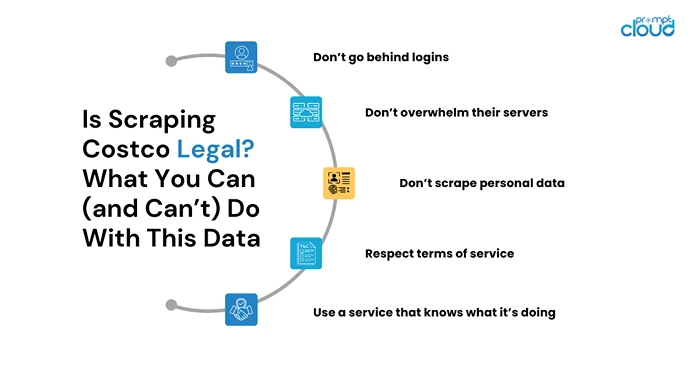
1. Don’t go behind logins
If you need to sign in to see certain Costco products or prices (like member-only deals), scraping that content can raise red flags. Stick to what’s publicly available. No shady tactics.
2. Don’t overwhelm their servers
Scraping too aggressively, too fast, or from the same IP over and over will not only get you blocked, but it could also get you flagged for abuse. This isn’t just about legality—it’s about being respectful. Crawl like a human would browse.
3. Don’t scrape personal data
You’re here to track Costco inventory, stock levels, and product pricing. Not customer info. The second you cross into scraping names, emails, or anything sensitive, you’re in “bad idea” territory.
4. Respect terms of service (but understand the nuance)
Yeah, Costco’s terms of service probably say “don’t scrape us.” But here’s the real-world truth: plenty of data teams and tools scrape sites with similar terms, as long as they’re scraping responsibly. Courts weigh public interest, data type, and scraping behavior more than just a line in the TOS.
5. Use a service that knows what it’s doing
If you’re serious about scraping at scale, don’t roll your half-baked script. Work with a service like PromptCloud that understands the legal landscape. They’ll handle IP rotation, rate limits, data hygiene, and make sure you’re not doing anything dumb that could get you in trouble.
Why PromptCloud Is Built for Scraping Retailers Like Costco at Scale
Scraping Costco sounds fun until your DIY script breaks for the third time in a week, you get IP-blocked, the site layout changes overnight, and your “automated” solution turns into a full-time babysitting job.
That’s where PromptCloud comes in. We don’t just give you raw HTML and tell you to figure it out, we handle the dirty work, the scaling, the clean-up, and the “oh crap, Costco changed their structure again” part of the job.
Here’s what that looks like in real life:
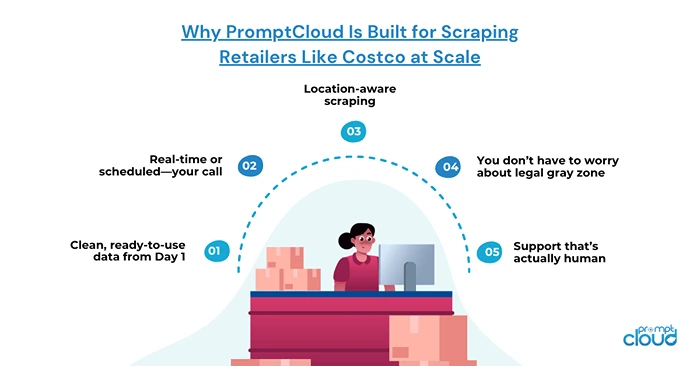
1. Clean, ready-to-use data from Day 1
You tell us what Costco product data you want—prices, stock status, availability by region, whatever. We build the crawler, run it, clean the output, and deliver structured data (CSV, JSON, API—you choose). No HTML junk, no debugging nightmares.
2. Real-time or scheduled—your call
Need inventory updates every morning before your pricing team logs in? Done. Want to track pricing hourly across 50 products? Cool. We’ll scale it however you want it—daily, hourly, weekly—without crashing their site or yours.
3. Location-aware scraping
Remember how Costco stock depends on ZIP code? We simulate locations and rotate IPs so you get accurate data for different regions. No missed products, no bad reads. That’s critical if you’re analyzing demand shifts across the U.S.
4. You don’t have to worry about legal gray zones
We stay on top of scraping best practices. No login scraping, no personal data, no shady stuff. Our infrastructure is built to be compliant, clean, and headache-free. You focus on the insights—we’ll handle the tech, the scale, and the risk.
5. Support that’s actually human
Stuff breaks. Sites change. You might want to tweak your fields or add a new category. We’re here when that happens, with real people who understand web scraping and don’t need you to submit a ticket into a black hole.
Whether you’re a retail analyst trying to predict inventory trends, a CPG brand watching wholesale movement, or a pricing team monitoring competitors, PromptCloud is built for this kind of work. And yes, Costco’s tricky. But we like tricky.
Costco’s Not Just a Retailer. It’s a Data Source You’d Be Crazy to Ignore.
Costco isn’t out here playing games. Their prices move markets. Their stockouts signal demand before most analytics dashboards even blink. And the weird part? All that info is just sitting there on their site—if you know how to grab it.
That’s what scraping is about. You’re not doing it to be sneaky. You’re doing it because real-time product data from Costco gives you a leg up. You know what’s in stock. What’s gone? What’s rising in price? What just came back? That’s not trivia—it’s actionable.
Whether you’re running a pricing strategy for a CPG brand, watching competitors in wholesale, or trying to stop guessing on demand, you should be watching Costco. And if you don’t want to write brittle code that breaks every time they update a class name, PromptCloud’s got your back. We’ve been scraping retailers for over a decade. This is what we do.
Let other teams wait around for reports. You? You’ll already know. Contact us today!
FAQs
1. Can I actually scrape Costco without getting into legal trouble?
Yeah. As long as you’re scraping stuff that’s public (no logins, no shady tactics), you’re on safe ground. PromptCloud makes sure the process is clean, ethical, and doesn’t step on toes.
2. What data can I scrape from Costco?
Prices, stock status, product names, SKUs, categories, and regional availability. Basically, anything a regular shopper can see, we can pull it for you at scale.
3. How often should I scrape Costco product data?
Depends on your goals. Need fresh pricing for a live dashboard? Do it hourly. Just tracking stock trends over time? Once or twice a day works. PromptCloud adjusts to whatever rhythm your business needs.
4. Why is Costco such a big deal to track anyway?
Because when a product disappears from Costco, or prices shift, that ripple hits every other channel—Amazon, Walmart, your shelves. If you’re not watching, you’re reacting late. Simple as that.
5. Do I need a dev team to work with PromptCloud?
Nope. You tell us what you want, we build it, run it, clean it, and drop the data wherever you need it. You focus on the insights—we’ll deal with all the scraping chaos behind the curtain.













